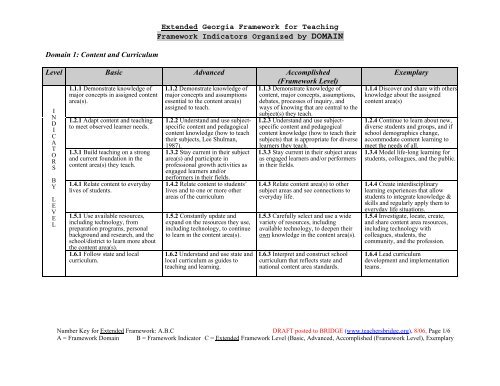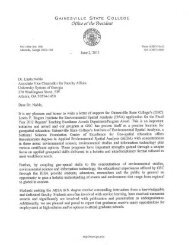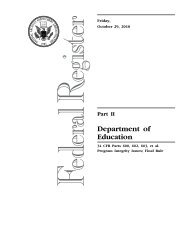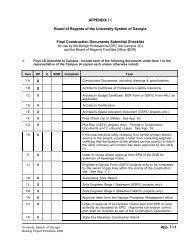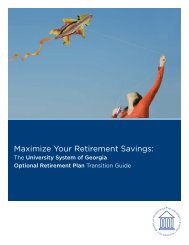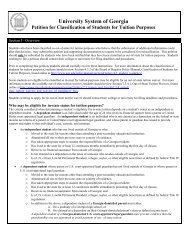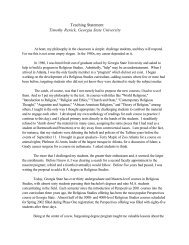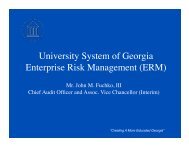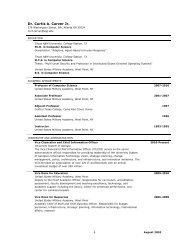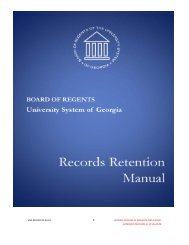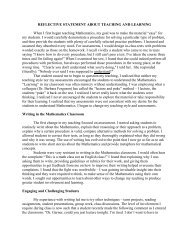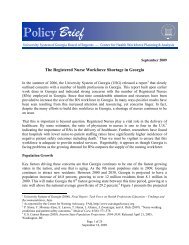Extended Georgia Framework for Teaching Framework Indicators ...
Extended Georgia Framework for Teaching Framework Indicators ...
Extended Georgia Framework for Teaching Framework Indicators ...
You also want an ePaper? Increase the reach of your titles
YUMPU automatically turns print PDFs into web optimized ePapers that Google loves.
Domain 1: Content and Curriculum<br />
<strong>Extended</strong> <strong>Georgia</strong> <strong>Framework</strong> <strong>for</strong> <strong>Teaching</strong><br />
<strong>Framework</strong> <strong>Indicators</strong> Organized by DOMAIN<br />
Level Basic Advanced Accomplished<br />
(<strong>Framework</strong> Level)<br />
1.1.1 Demonstrate knowledge of<br />
major concepts in assigned content<br />
area(s).<br />
I<br />
N<br />
D<br />
I<br />
C<br />
A<br />
T<br />
O<br />
R<br />
S<br />
B<br />
Y<br />
L<br />
E<br />
V<br />
E<br />
L<br />
1.2.1 Adapt content and teaching<br />
to meet observed learner needs.<br />
1.3.1 Build teaching on a strong<br />
and current foundation in the<br />
content area(s) they teach.<br />
1.4.1 Relate content to everyday<br />
lives of students.<br />
1.5.1 Use available resources,<br />
including technology, from<br />
preparation programs, personal<br />
background and research, and the<br />
school/district to learn more about<br />
the content area(s).<br />
1.6.1 Follow state and local<br />
curriculum.<br />
1.1.2 Demonstrate knowledge of<br />
major concepts and assumptions<br />
essential to the content area(s)<br />
assigned to teach.<br />
1.2.2 Understand and use subjectspecific<br />
content and pedagogical<br />
content knowledge (how to teach<br />
their subjects, Lee Shulman,<br />
1987).<br />
1.3.2 Stay current in their subject<br />
area(s) and participate in<br />
professional growth activities as<br />
engaged learners and/or<br />
per<strong>for</strong>mers in their fields.<br />
1.4.2 Relate content to students’<br />
lives and to one or more other<br />
areas of the curriculum<br />
1.5.2 Constantly update and<br />
expand on the resources they use,<br />
including technology, to continue<br />
to learn in the content area(s).<br />
1.6.2 Understand and use state and<br />
local curriculum as guides to<br />
teaching and learning.<br />
1.1.3 Demonstrate knowledge of<br />
content, major concepts, assumptions,<br />
debates, processes of inquiry, and<br />
ways of knowing that are central to the<br />
subject(s) they teach.<br />
1.2.3 Understand and use subjectspecific<br />
content and pedagogical<br />
content knowledge (how to teach their<br />
subjects) that is appropriate <strong>for</strong> diverse<br />
learners they teach.<br />
1.3.3 Stay current in their subject areas<br />
as engaged learners and/or per<strong>for</strong>mers<br />
in their fields.<br />
1.4.3 Relate content area(s) to other<br />
subject areas and see connections to<br />
everyday life.<br />
1.5.3 Carefully select and use a wide<br />
variety of resources, including<br />
available technology, to deepen their<br />
own knowledge in the content area(s).<br />
1.6.3 Interpret and construct school<br />
curriculum that reflects state and<br />
national content area standards.<br />
Exemplary<br />
1.1.4 Discover and share with others<br />
knowledge about the assigned<br />
content area(s)<br />
1.2.4 Continue to learn about new,<br />
diverse students and groups, and if<br />
school demographics change,<br />
accommodate content learning to<br />
meet the needs of all.<br />
1.3.4 Model life-long learning <strong>for</strong><br />
students, colleagues, and the public.<br />
1.4.4 Create interdisciplinary<br />
learning experiences that allow<br />
students to integrate knowledge &<br />
skills and regularly apply them to<br />
everyday life situations.<br />
1.5.4 Investigate, locate, create,<br />
and share content area resources,<br />
including technology with<br />
colleagues, students, the<br />
community, and the profession.<br />
1.6.4 Lead curriculum<br />
development and implementation<br />
teams.<br />
Number Key <strong>for</strong> <strong>Extended</strong> <strong>Framework</strong>: A.B.C DRAFT posted to BRIDGE (www.teachersbridge.org), 8/06, Page 1/6<br />
A = <strong>Framework</strong> Domain B = <strong>Framework</strong> Indicator C = <strong>Extended</strong> <strong>Framework</strong> Level (Basic, Advanced, Accomplished (<strong>Framework</strong> Level), Exemplary
<strong>Extended</strong> <strong>Georgia</strong> <strong>Framework</strong> <strong>for</strong> <strong>Teaching</strong><br />
<strong>Framework</strong> <strong>Indicators</strong> Organized by DOMAIN<br />
Domain 2: Knowledge of Students<br />
Level Basic Advanced Accomplished<br />
(<strong>Framework</strong> Level)<br />
2.1.1 Believe that all students can<br />
learn.<br />
I<br />
N<br />
D<br />
I<br />
C<br />
A<br />
T<br />
O<br />
R<br />
S<br />
B<br />
Y<br />
L<br />
E<br />
V<br />
E<br />
L<br />
2.2.1 Understand and use basic<br />
theories of learning to create<br />
productive classroom instruction.<br />
2.3.1 Communicate respect <strong>for</strong> and<br />
develop rapport with all students.<br />
2.4.1 Analyze student data both<br />
independently and with colleagues.<br />
2.5.1 Identify students’ stages of<br />
development, multiple intelligences,<br />
learning styles, and areas of<br />
exceptionality and, with help, begin<br />
to develop and use a repertoire of<br />
strategies to accommodate individual<br />
needs.<br />
2.6.1 Communicate with families<br />
regarding student progress through<br />
required school and district<br />
procedures.<br />
2.1.2 Hold high<br />
expectations and support<br />
the learning of all students.<br />
2.2.2 Demonstrate ongoing<br />
and increasing knowledge<br />
of how students learn as<br />
individuals and groups.<br />
2.3.2 Identify, create, and<br />
use strategies <strong>for</strong><br />
identifying students’<br />
varied needs: physical,<br />
social, emotional, moral,<br />
and intellectual.<br />
2.4.2 Use student data<br />
from both inside and<br />
outside the school to<br />
support student learning.<br />
2.5.2 Differentiate<br />
instruction to meet the<br />
individual needs of all<br />
students.<br />
2.6.2 Interact with students<br />
and their families in a<br />
positive and professional<br />
manner including<br />
suggestions to improve<br />
per<strong>for</strong>mance.<br />
2.1.3 Believe that all children can<br />
learn at high levels and hold high<br />
expectations <strong>for</strong> all.<br />
2.2.3 Understand how learning<br />
occurs in general and in the<br />
content areas (e.g., how diverse<br />
learners construct knowledge,<br />
acquire skills, and develop habits<br />
of mind).<br />
2.3.3 Are sensitive, alert, and<br />
responsive to all aspects of a<br />
child’s well being.<br />
2.4.3 Understand how factors in<br />
environments inside and outside<br />
of school may influence students’<br />
lives and learning.<br />
2.5.3 Are in<strong>for</strong>med about and<br />
adapt their work based on<br />
students’ stages of development,<br />
multiple intelligences, learning<br />
styles, and areas of exceptionality.<br />
2.6.3 Establish respectful and<br />
productive relationships with<br />
families and seek to develop<br />
cooperative partnerships in<br />
support of student learning and<br />
well-being.<br />
Exemplary<br />
2.1.4 Strive to help colleagues, students, and<br />
community members come to hold high<br />
expectations and support the learning of all<br />
students.<br />
2.2.4 Use deep understanding of student<br />
learning to create dynamic and purposeful<br />
instructional opportunities in which students<br />
thrive.<br />
2.3.4 Act as a child advocate in the school<br />
and community.<br />
2.4.4 Help school colleagues, community<br />
members, students, and their families<br />
overcome challenges and build on strengths<br />
in students’ environments in order to<br />
enhance student learning.<br />
2.5.4 Create learning situations that build<br />
on students’ multiple, complex, and unique<br />
needs as learners both in the classroom and<br />
across the school.<br />
2.6.4 Build and expand on established<br />
home-school-community partnerships to<br />
improve the learning and well-being of all<br />
students.<br />
Number Key <strong>for</strong> <strong>Extended</strong> <strong>Framework</strong>: A.B.C DRAFT posted to BRIDGE (www.teachersbridge.org), 8/06, Page 2/6<br />
A = <strong>Framework</strong> Domain B = <strong>Framework</strong> Indicator C = <strong>Extended</strong> <strong>Framework</strong> Level (Basic, Advanced, Accomplished (<strong>Framework</strong> Level), Exemplary
Domain 3: Learning Environments<br />
<strong>Extended</strong> <strong>Georgia</strong> <strong>Framework</strong> <strong>for</strong> <strong>Teaching</strong><br />
<strong>Framework</strong> <strong>Indicators</strong> Organized by DOMAIN<br />
Level Basic Advanced Accomplished<br />
(<strong>Framework</strong> Level)<br />
3.1.1 Create a learning 3.1.2 Create a learning<br />
3.1.3 Create a learning community<br />
environment in which students environment in which students in which students assume<br />
can learn both independently accept responsibility <strong>for</strong> their responsibility, participate in<br />
and collaboratively.<br />
own learning and respect the decision-making, and work both<br />
I<br />
N<br />
D<br />
I<br />
C<br />
A<br />
T<br />
O<br />
R<br />
S<br />
B<br />
Y<br />
L<br />
E<br />
V<br />
E<br />
L<br />
3.2.1 Organize and manage<br />
time, space, activities,<br />
technology, software, and other<br />
resources necessary <strong>for</strong><br />
providing learning activities <strong>for</strong><br />
students.<br />
3.3.1 Understand the<br />
importance of, explore options<br />
<strong>for</strong>, and build a functional plan<br />
<strong>for</strong> classroom management.<br />
3.4.1 Seek, use, and refine<br />
strategies <strong>for</strong> motivating<br />
learners.<br />
3.5.1 Take steps toward<br />
creating a culturally responsive<br />
classroom.<br />
3.6.1 Learn about and use<br />
resources specific to the school,<br />
district, and community.<br />
3.7.1 Develop appropriate<br />
verbal, nonverbal, and media<br />
communication techniques to<br />
foster supportive learningbased<br />
interactions in the<br />
classroom.<br />
learning needs of others.<br />
3.2.2 Organize, allocate, and<br />
manage time, space, activities,<br />
technology, software, and other<br />
resources to increase active<br />
engagement of students in<br />
learning activities.<br />
3.3.2 Practice effective<br />
classroom management<br />
strategies.<br />
3.4.2 Implement strategies <strong>for</strong><br />
organizing and supporting<br />
student learning that are based on<br />
human motivation and behavior.<br />
3.5.2 Practice sensitivity to<br />
students' cultures, experiences,<br />
and communities in all aspects of<br />
teaching.<br />
3.6.2 Access and become<br />
involved with school, district,<br />
and community resources as an<br />
integral part of teaching.<br />
3.7.2 Expand on their repertoire<br />
of verbal, nonverbal, and media<br />
communication techniques to<br />
foster collaboration and<br />
supportive interaction in the<br />
classroom.<br />
collaboratively and independently.<br />
3.2.3 Organize, allocate, and<br />
manage time, space, activities,<br />
technology and other resources to<br />
provide active and equitable<br />
engagement of diverse students in<br />
productive tasks.<br />
3.3.3 Understand and implement<br />
effective classroom management.<br />
3.4.3 Recognize the value of and<br />
use knowledge about human<br />
motivation and behavior to develop<br />
strategies <strong>for</strong> organizing and<br />
supporting student learning.<br />
3.5.3 Are sensitive to and use<br />
knowledge of students’ unique<br />
cultures, experiences, and<br />
communities to sustain a culturally<br />
responsive classroom.<br />
3.6.3 Access school, district, and<br />
community resources in order to<br />
foster students’ learning and well<br />
being.<br />
3.7.3 Use effective verbal,<br />
nonverbal, and media<br />
communication techniques to foster<br />
active inquiry, collaboration, and<br />
supportive interaction in the<br />
classroom.<br />
Exemplary<br />
3.1.4 Prepare students to be active<br />
members of a democratic society.<br />
3.2.4 Create, sustain, and expand dynamic<br />
learning environments in which teachers<br />
and students make decisions about the<br />
organization, allocation, and management<br />
of time, space, activities, and other<br />
resources to further the learning of all.<br />
3.3.4 Have a proactive management style in<br />
which students monitor and adjust their<br />
own behaviors when appropriate.<br />
3.4.4 Create an environment in which<br />
students are both self-motivated and show<br />
leadership in motivating one another to<br />
achieve learning goals.<br />
3.5.4 Incorporate students’ cultures,<br />
experiences, communities as classroom<br />
resources to increase student learning and<br />
sustain a culturally responsive classroom.<br />
3.6.4 Utilize and help to create school,<br />
district, and community resources as<br />
extensions of the classroom.<br />
3.7.4 Help others acquire effective verbal,<br />
nonverbal, media communication<br />
techniques <strong>for</strong> use in classroom, school,<br />
and society.<br />
Number Key <strong>for</strong> <strong>Extended</strong> <strong>Framework</strong>: A.B.C DRAFT posted to BRIDGE (www.teachersbridge.org), 8/06, Page 3/6<br />
A = <strong>Framework</strong> Domain B = <strong>Framework</strong> Indicator C = <strong>Extended</strong> <strong>Framework</strong> Level (Basic, Advanced, Accomplished (<strong>Framework</strong> Level), Exemplary
<strong>Extended</strong> <strong>Georgia</strong> <strong>Framework</strong> <strong>for</strong> <strong>Teaching</strong><br />
<strong>Framework</strong> <strong>Indicators</strong> Organized by DOMAIN<br />
Domain 4: Assessment<br />
I<br />
N<br />
D<br />
I<br />
C<br />
A<br />
T<br />
O<br />
R<br />
S<br />
B<br />
Y<br />
L<br />
E<br />
V<br />
E<br />
L<br />
Basic Advanced Accomplished<br />
(<strong>Framework</strong> Level)<br />
4.1.2 Use measurement theory to make<br />
instructional decisions and connections<br />
among different types of assessments.<br />
4.1.1 Have a basic understanding<br />
of assessment and measurement<br />
theory.<br />
4.2.1 Collect and use<br />
preassessment data to select<br />
student learning goals.<br />
4.3.1 Use <strong>for</strong>mative and<br />
summative assessments at<br />
appropriate points in the learning<br />
process.<br />
4.4.1 Identify students’ learning<br />
needs and provide students with<br />
goals <strong>for</strong> learning.<br />
4.5.1 Develop and implement<br />
consistent, fair, and accurate<br />
grading procedures.<br />
4.6.1 Report student progress to<br />
students, families, and<br />
administrators using required<br />
procedures.<br />
4.7.1 Use required resources to<br />
keep accurate and up-to-date<br />
records and reports of student<br />
work and behavior.<br />
4.8.1 Examine ways to identify<br />
student strengths and weaknesses<br />
through various assessment<br />
processes and methods.<br />
4.2.2 Collect and use preassessment<br />
data to select or design appropriate<br />
student learning goals.<br />
4.3.2 Demonstrate a growing<br />
awareness of the connections between<br />
classroom-based assessment methods<br />
and instructional decisions.<br />
4.4.2 Involve learners in selfassessment<br />
and personal goal setting.<br />
4.5.2 Develop grading procedures that<br />
are aligned with actual student<br />
learning.<br />
4.6.2 Examine assessment data <strong>for</strong><br />
evidence of student progress and<br />
communicate findings to students,<br />
families, colleagues, and<br />
administrators.<br />
4.7.2 Use required resources, including<br />
available technology/software, to keep<br />
accurate and up-to-date records of<br />
student work, behavior, and<br />
accomplishments (at proficient level).<br />
4.8.2 Use assessment to identify<br />
student strengths and weaknesses.<br />
4.1.3 Understand measurement<br />
theory and the characteristics,<br />
uses, and issues of different<br />
types of assessment.<br />
4.2.3 Use preassessment data to<br />
select or design clear,<br />
significant, varied and<br />
appropriate student learning<br />
goals.<br />
4.3.3 Choose, develop, and use<br />
classroom-based assessment<br />
methods appropriate <strong>for</strong><br />
instructional decisions.<br />
4.4 .3 Involve learners in selfassessment,<br />
helping them<br />
become aware of their strengths<br />
& needs & encouraging them to<br />
set personal goals <strong>for</strong> learning.<br />
4.5.3 Develop and use valid,<br />
equitable grading procedures<br />
based on student learning<br />
4.6.3 Use assessment data to<br />
communicate student progress<br />
knowledgeably and responsibly<br />
to students, parents, and other<br />
school personnel.<br />
4.7.3 Use resources, including<br />
available technology, to keep<br />
accurate and up-to-date records<br />
of student work, behavior, and<br />
accomplishments.<br />
4.8.3 Are committed to using<br />
assessment to identify student<br />
strengths and needs and<br />
promote student growth.<br />
Exemplary<br />
4.1.4 Articulate to others their<br />
understanding and use of measurement<br />
theory in making instructional decisions<br />
regarding classroom assessment and<br />
standardized testing.<br />
4.2.4 Share strategies <strong>for</strong> analyzing and<br />
using data to select or design clear,<br />
significant, varied, and appropriate student<br />
learning goals <strong>for</strong> different types of<br />
learners.<br />
4.3.4 Assist colleagues and students in<br />
understanding the connection between<br />
appropriate assessment methods and<br />
student achievement.<br />
4.4.4 Help all students use self-assessment<br />
data and accept responsibility <strong>for</strong> their<br />
learning goals and achievement.<br />
4.5.4 Continue to refine and revise<br />
personal grading procedures through<br />
collaboration with colleagues.<br />
4.6.4 Examine and communicate classroom<br />
assessment data in the context of school or<br />
district assessment data to determine and<br />
communicate trends in student progress.<br />
4.7.4 Use and develop resources, including<br />
available technology, to work with<br />
colleagues to analyze records of student<br />
work, behavior, and accomplishments to<br />
enhance school improvement.<br />
4.8.4 Work with colleagues to ensure that<br />
all students have opportunities to be<br />
recognized <strong>for</strong> accomplishments, strengths,<br />
and talents and to work toward<br />
improvement in areas of need.<br />
Number Key <strong>for</strong> <strong>Extended</strong> <strong>Framework</strong>: A.B.C DRAFT posted to BRIDGE (www.teachersbridge.org), 8/06, Page 4/6<br />
A = <strong>Framework</strong> Domain B = <strong>Framework</strong> Indicator C = <strong>Extended</strong> <strong>Framework</strong> Level (Basic, Advanced, Accomplished (<strong>Framework</strong> Level), Exemplary
Domain 5: Planning and Instruction<br />
<strong>Extended</strong> <strong>Georgia</strong> <strong>Framework</strong> <strong>for</strong> <strong>Teaching</strong><br />
<strong>Framework</strong> <strong>Indicators</strong> Organized by DOMAIN<br />
Level Basic Advanced Accomplished<br />
(<strong>Framework</strong> Level)<br />
5.1.1 Locate, comprehend,<br />
and build rationales from<br />
5.1.2 Develop rationales <strong>for</strong> their<br />
instructional choices and use them<br />
5.1.3 Articulate clear and<br />
defensible rationales <strong>for</strong> their<br />
curriculum guides, other appropriately.<br />
choices of curriculum materials<br />
applicable documents, and<br />
experienced colleagues.<br />
and instructional strategies.<br />
I<br />
N<br />
D<br />
I<br />
C<br />
A<br />
T<br />
O<br />
R<br />
S<br />
B<br />
Y<br />
L<br />
E<br />
V<br />
E<br />
L<br />
5.2.1 Plan and carry out<br />
instruction based on state<br />
and local per<strong>for</strong>mance<br />
standards.<br />
5.3.1 Select and vary<br />
instructional strategies,<br />
assessing their impact on<br />
student engagement and<br />
learning.<br />
5.4.1 Observe students<br />
closely and begin to<br />
discover how adjustments in<br />
teaching can impact<br />
learning.<br />
5.5.1 Explore teaching roles<br />
to discover appropriate<br />
approaches <strong>for</strong> assigned<br />
students.<br />
5.6.1 Assess individual<br />
learners needs and seek<br />
resources to improve<br />
instruction and learning.<br />
5.7.1 Learn to work and<br />
plan productively as part of<br />
a team, grade level, and/or<br />
department group.<br />
5.2.2 Build a complex understanding<br />
of planning that grows out of<br />
standards and includes increasingly<br />
integrated knowledge of content and<br />
curriculum, students, learning<br />
environments, and assessment.<br />
5.3.2 Select and vary instructional<br />
strategies based on knowledge of the<br />
specific learners in a classroom in<br />
order to engage all students.<br />
5.4.2 Attend to students as learners<br />
and adjust strategies as needed.<br />
5.5.2 Vary teaching roles to maintain<br />
teacher and student interest.<br />
5.6.2 Develop a repertoire of<br />
resources, materials, and<br />
technology/software to enhance<br />
instruction and learning <strong>for</strong> all<br />
students.<br />
5.7.2 Plan with others to create<br />
coherent experiences to enhance<br />
student learning.<br />
5.2.3 Plan and carry out instruction<br />
based upon knowledge of content<br />
standards, curriculum, students,<br />
learning environments, and<br />
assessment.<br />
5.3.3 Understand and use a variety<br />
of instructional strategies<br />
appropriately to maintain student<br />
engagement and support the<br />
learning of all students.<br />
5.4.3 Monitor and adjust strategies<br />
in response to learner feedback.<br />
5.5.3 Vary their roles in the<br />
instructional process (e.g.<br />
instructor, facilitator, coach,<br />
audience) in relation to the content<br />
and purposes of instruction and<br />
the needs of students.<br />
5.6.3 Use appropriate resources,<br />
materials, and technology to<br />
enhance instruction <strong>for</strong> diverse<br />
learners.<br />
5.7.3 Value and engage in<br />
planning as a collegial activity.<br />
Exemplary<br />
5.1.4 Generate, share, and revise rationales<br />
<strong>for</strong> instructional choices based on learning<br />
theories and honed in practice, classroom<br />
research, and collaboration with<br />
colleagues.<br />
5.2.4 Plan and carry out instruction based<br />
on day-to-day and long-term goal setting<br />
and data analysis in order to improve the<br />
learning of all students.<br />
5.3.4 Seek, use, create, share, and critique a<br />
wide range of instructional strategies that<br />
engage specific students and provide<br />
multiple perspectives on key concepts,<br />
problems, and areas of knowledge.<br />
5.4.4 Collaborate with learners and<br />
colleagues to create dynamic, productive<br />
classroom and school learning experiences<br />
and environments.<br />
5.5.4 Teach students to create, carry out,<br />
and assess a variety of roles as learners<br />
and leaders, and model this type of<br />
teaching <strong>for</strong> colleagues.<br />
5.6.4 Support the creation and use of<br />
valuable resources, materials, and<br />
technology/software (including those<br />
generated by students, learning<br />
community groups, etc.) that help manage<br />
and enhance instruction <strong>for</strong> all.<br />
5.7.4 Work in learning communities<br />
regularly, leading others in planning,<br />
curriculum design, instruction, and<br />
assessment to increase student learning in<br />
class, school, district, and community.<br />
Number Key <strong>for</strong> <strong>Extended</strong> <strong>Framework</strong>: A.B.C DRAFT posted to BRIDGE (www.teachersbridge.org), 8/06, Page 5/6<br />
A = <strong>Framework</strong> Domain B = <strong>Framework</strong> Indicator C = <strong>Extended</strong> <strong>Framework</strong> Level (Basic, Advanced, Accomplished (<strong>Framework</strong> Level), Exemplary
<strong>Extended</strong> <strong>Georgia</strong> <strong>Framework</strong> <strong>for</strong> <strong>Teaching</strong><br />
<strong>Framework</strong> <strong>Indicators</strong> Organized by DOMAIN<br />
Domain 6: Professionalism<br />
Level Basic Advanced Accomplished<br />
(<strong>Framework</strong> Level)<br />
6.1.1 Learn basic in<strong>for</strong>mation about the<br />
history, ethics, organization, and<br />
practices of education.<br />
I<br />
N<br />
D<br />
I<br />
C<br />
A<br />
T<br />
O<br />
R<br />
S<br />
B<br />
Y<br />
L<br />
E<br />
V<br />
E<br />
L<br />
6.2.1 Learn about, locate resources <strong>for</strong>,<br />
and follow laws related to rights and<br />
responsibilities of students, educators,<br />
and families.<br />
6.3.1 Adhere to state and local Codes of<br />
Ethics, including school and district<br />
policies, in both professional and personal<br />
settings, and model ethical behavior <strong>for</strong><br />
students.<br />
6.4.1 Reflect on teaching practice and<br />
begin to examine the connections to<br />
student learning.<br />
6.5.1 Self-assess teaching strengths and<br />
areas <strong>for</strong> improvement, seeking and using<br />
guidance from mentors and instructional<br />
leaders in order to improve in key areas.<br />
6.6.1 Work through appropriate channels<br />
to seek answers to questions, voice<br />
concerns, explore ideas, and speak out<br />
about issues that matter to them and their<br />
students.<br />
6.7.1 Accept entry-level leadership roles<br />
(e.g., clubs, special topics, coaching) with<br />
support of identified mentors,<br />
6.1.2 Observe, inquire, learn<br />
more about, and make<br />
connections among the history,<br />
ethics, politics, organization,<br />
and practices of education.<br />
6.2.2 Abide by laws related to<br />
rights and the responsibilities of<br />
students, educators, and families.<br />
6.3.2 Understand, follow, and<br />
support state and local Codes of<br />
Ethics, including school and<br />
district policies, and involve<br />
students in studying ethical<br />
behavior.<br />
6.4.2 Reflect on teaching<br />
practice in order to improve<br />
student learning.<br />
6.5.2 Continue learning in a<br />
variety of ways and actively seek<br />
opportunities <strong>for</strong> professional<br />
improvement.<br />
6.6.2 Explore and establish<br />
appropriate and meaningful<br />
ways to advocate <strong>for</strong> improved<br />
curriculum, instruction, learning<br />
environments and opportunities<br />
that support the diverse needs of<br />
learners.<br />
6.7.2 Expand leadership and<br />
support roles and work<br />
productively as part of a school<br />
6.1.3 Continually examine and<br />
extend their knowledge of the<br />
history, ethics, politics,<br />
organization, and practices of<br />
education.<br />
6.2.3 Understand and<br />
implement laws related to<br />
rights and responsibilities of<br />
students, educators, and<br />
families.<br />
6.3.3 Follow established codes<br />
of professional conduct,<br />
including school and district<br />
policies.<br />
6.4.3 Systematically reflect on<br />
teaching and learning to<br />
improve their own practice.<br />
6.5.3 Seek opportunities to learn<br />
based upon reflection, input<br />
from others, and career goals.<br />
6.6.3 Advocate <strong>for</strong> curriculum,<br />
instruction, learning<br />
environments, and<br />
opportunities that support the<br />
diverse needs of and high<br />
expectations <strong>for</strong> all students.<br />
6.7.3 Assume leadership and<br />
support roles as part of a school<br />
team.<br />
Exemplary<br />
6.1.4 Use their knowledge of the<br />
history, ethics, politics, organization,<br />
and practices of education to extend<br />
their professional practice and<br />
become change agents when<br />
appropriate.<br />
6.2.4 Use knowledge of educational<br />
law, school contexts, and democratic<br />
processes to support and improve the<br />
legal rights and responsibilities of all.<br />
6.3.4 Exemplify the highest standards<br />
of professional conduct when<br />
interacting with students, families, &<br />
other educators and help others<br />
interact in productive, ethical ways.<br />
6.4.4 Work in reflective communities<br />
of learners who share insights,<br />
examine student work, and confront<br />
challenges in order to improve<br />
teaching, learning, school, &<br />
community.<br />
6.5.4 Become lifelong, goaloriented,<br />
self-directed learners and<br />
leaders.<br />
6.6.4 Become recognized as an<br />
activist who both speaks out and<br />
acts in support of education,<br />
students, and families at local, state,<br />
and/or national levels.<br />
6.7.4 Mentor and support new<br />
leaders at grade, team, department,<br />
school, and district levels.<br />
administrators, coaches, and facilitators. team.<br />
Number Key <strong>for</strong> <strong>Extended</strong> <strong>Framework</strong>: A.B.C DRAFT posted to BRIDGE (www.teachersbridge.org), 8/06, Page 6/6<br />
A = <strong>Framework</strong> Domain B = <strong>Framework</strong> Indicator C = <strong>Extended</strong> <strong>Framework</strong> Level (Basic, Advanced, Accomplished (<strong>Framework</strong> Level), Exemplary
<strong>Extended</strong> <strong>Georgia</strong> <strong>Framework</strong> <strong>for</strong> <strong>Teaching</strong><br />
<strong>Framework</strong> <strong>Indicators</strong> Organized by DOMAIN<br />
Number Key <strong>for</strong> <strong>Extended</strong> <strong>Framework</strong>: A.B.C DRAFT posted to BRIDGE (www.teachersbridge.org), 8/06, Page 7/6<br />
A = <strong>Framework</strong> Domain B = <strong>Framework</strong> Indicator C = <strong>Extended</strong> <strong>Framework</strong> Level (Basic, Advanced, Accomplished (<strong>Framework</strong> Level), Exemplary


